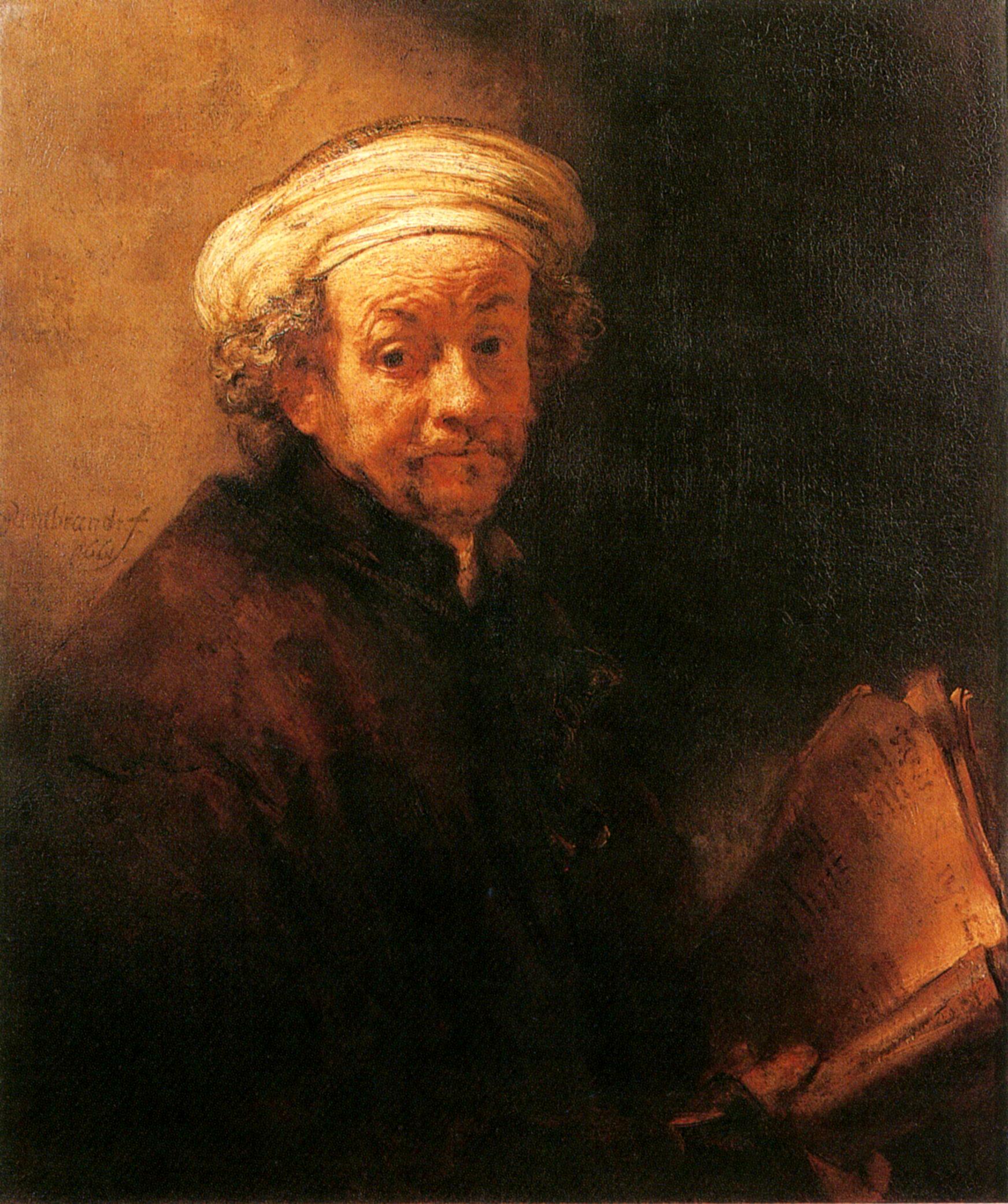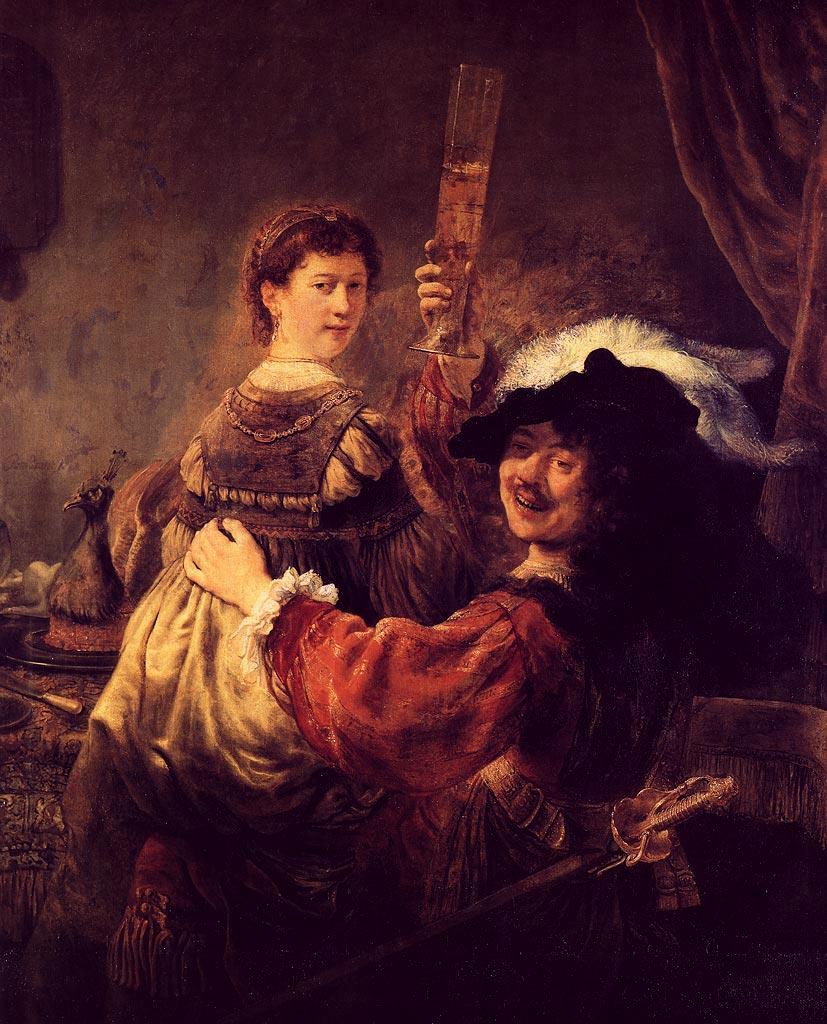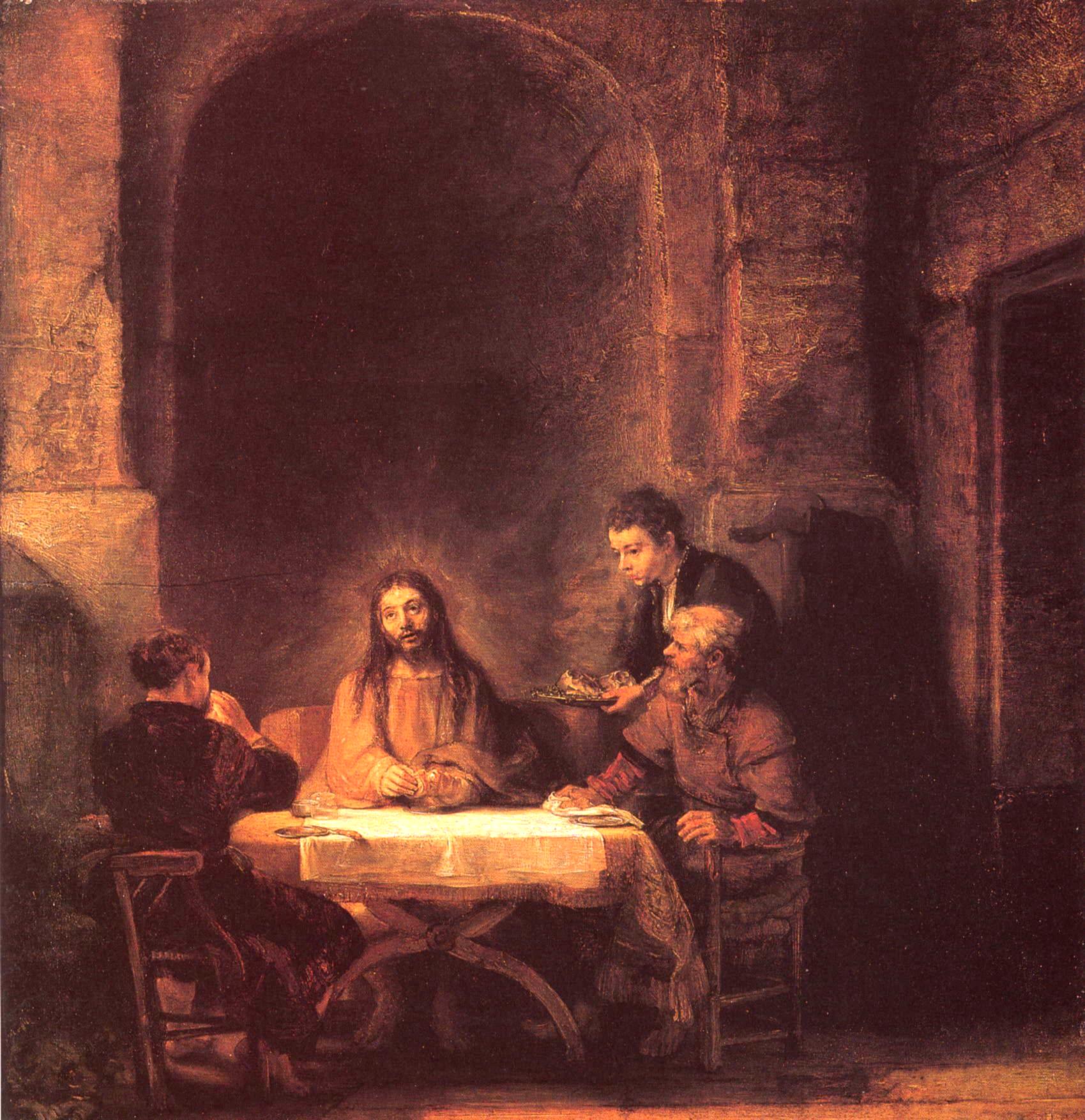|
Rembrandt Harmensz van Rijn 1606 - 1669 |
|
Rembrandt Harmensz van Rijn 1606 - 1669 |
| Rembrandt was born into the family
of a miller in Leyden in 1606. He began studying painting at age
14 -- picking up on the Caravaggio style from copies of that artist's
works he had seen. He moved to Amstedam to continue his studies --
and soon his reputation as an artist began to grow. Particularly
well-liked were his scenes from the Old Testament and his portraits.
By the time we was thirty he was in charge of a large workshop, was happily
married to a young woman of a respectable family, Saskia van Uylenborch,
and was very prosperous as an artist.
But this situation did not last. In 1642 his wife Saskia died, leaving him with a son Titus to bring up on his own. His servant and mistress Hendrickje Stoffels moved in with him, eventually giving birth to a daughter. His style soon began to shift from the glamour of outward appearances to the depths of the inner souls of his subjects -- something not necessarily in high demand by his potential art clients. His business began to slack off. He began to paint more for himself than for clients. But it was only this point that his true artistic genius began to reveal itself. He found himself increasingly isolated in Amsterdam society -- and in 1654 the Consistory of the Reform Church of Amsterdam censured him publicly for living out of wedlock. His financial fortune also disappeared. He had spent much of his income on a growing art collection and had become involved in some speculative enterprises which had lost him a large amount of money. By 1656 he had to declare himself bankrupt and was forced to sell his house and possessions. Tragedy never left him. In 1663 Hendrickje died; in 1669 his son Titus died, leaving behind a young wife and a daughter. A few months later, at the age of sixty-three, Rembrandt died, a man forgotten by the world around him. |

Rembrandt Harmensz van Rijn – Self-Portrait (1629) oil on canvas

Rembrandt Harmensz van Rijn – Self-Portrait (1658) oil on canvas

Rembrandt Harmensz van Rijn
– Self-Portrait (1658) oil on canvas
Washington, D.C., National
Gallery of Art

Rembrandt Harmensz van Rijn
– Self-Portrait (1660) oil on canvas
New York, The Metropolitan
Museum of Art

Rembrandt Harmenz van Rijn
– Self-Portrait as the Apostle Paul (1661) oil on canvas
Amsterdam, Rijksmuseum

Rembrandt Harmensz van Rijn
– Self-Portrait at Old Age (1669) oil on canvas
London, National Gallery

Rembrandt Harmensz van Rijn
– The Stoning of St. Stephen (1625) oil on panel
Lyon, Musée des Beaux-Arts

Rembrandt Harmensz van Rijn – The Artist in His Studio (1629)

Rembrandt Harmensz van Rijn
– Jeremiah lamenting over the destruction of Jerusalem (1630) oil
on panel
Amsterdam, Rijksmuseum

Rembrandt Harmensz van Rijn
– Jeremiah lamenting over the destruction of Jerusalem (1630) oil
on panel
Paris, Musée du Louvre

Rembrandt Harmensz van Rijn
– The Anatomy Lesson of Dr. Tulp (1632) oil on canvas
The Hague, Mauritshuis

Rembrandt Harmensz van Rijn
– Portrait of Johannes Uytenbogaert (1632) oil on canvas
Amsterdam, Rijksmuseum

Rembrandt Harmensz van Rijn
– Woman Wearing a Gold Chain - 1634
Museum of Fine Arts, Boston
(www.artunframed.com/rembrandtthumb.htm)

Rembrandt Harmensz van Rijn – Descent from the cross - 1634

Rembrandt Harmensz van Rijn
– Abraham's Sacrifice of Isaac - 1634
Saint Petersburg, Hermitage

Rembrandt Harmensz van Rijn
– Portrait of Saskia as Flora (1635) oil on canvas
London, National Gallery

Rembrandt Harmensz van Rijn
– The Artist and His Wife Saskia (1635-1636) oil on canvas
Dresden, Staatliche Kunstsammlungen,
Alte Meister

Rembrandt Harmensz van Rijn
– Lady with an Ostrich Fan (1635-1636) oil on canvas
Washington, D.C., National
Gallery

Rembrandt Harmensz van Rijn
– The Binding of Sampson (1636) oil on canvas
Frankfurt am Main, Städelsches
Kunstinstitut

Rembrandt Harmensz van Rijn
– Belshazzar's Feast (1636-1638) oil on canvas
London, National Gallery

Rembrandt Harmensz van Rijn
– Night Watch (1642) oil on canvas
Amsterdam, Rijksmuseum

Rembrandt Harmensz van Rijn
– The Mill (1645-1648) oil on canvas
Washington, D.C., National
Gallery of Art

Rembrandt Harmensz van Rijn
– The Supper at Emmaus (1648) oil on wood
Paris, Musée du Louvre

Rembrandt Harmensz van Rijn
– Girl with a Broom (1651) oil on canvas
Washington, D.C., National
Gallery of Art

Rembrandt Harmensz van Rijn
– Aristotle contemplating the bust of Homer (1653) oil on canvas
New York, Metropolitan Museum
of Art

Rembrandt Harmensz van Rijn
– Bathsheba (Hendrickje) (1654) oil on canvas
Paris, Musée du Louvre

Rembrandt Harmensz van Rijn
– A Woman Bathing in a Stream (Hendrickje) (1654) oil
on canvas
London, National Gallery

Rembrandt Harmensz van Rijn
– Jacob blessing Joseph's second son (1656) oil on canvas
Kassel, Gemäldegalerie

Rembrandt Harmensz van Rijn
– Rembrandt's son Titus as a monk (1660) oil on canvas
Amsterdam, Rijksmuseum

Rembrandt Harmensz van Rijn
– The Syndics of the Clothmaker's Guild (1662) oil on canvas
Amsterdam, Rijksmuseum

Rembrandt Harmensz van Rijn
– Return of the Prodigal Son (1668-1669) oil on canvas
St. Petersburg, Hermitage